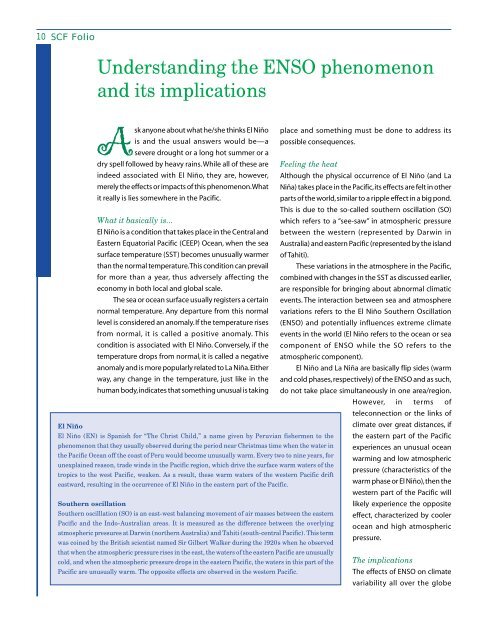Read More - Philippine Institute for Development Studies
Read More - Philippine Institute for Development Studies
Read More - Philippine Institute for Development Studies
You also want an ePaper? Increase the reach of your titles
YUMPU automatically turns print PDFs into web optimized ePapers that Google loves.
10 SCF Folio<br />
Understanding the ENSO phenomenon<br />
and its implications<br />
Ask anyone about what he/she thinks El Niño place and something must be done to address its<br />
is and the usual answers would be—a possible consequences.<br />
severe drought or a long hot summer or a<br />
dry spell followed by heavy rains. While all of these are<br />
indeed associated with El Niño, they are, however,<br />
merely the effects or impacts of this phenomenon. What<br />
it really is lies somewhere in the Pacific.<br />
Feeling the heat<br />
Although the physical occurrence of El Niño (and La<br />
Niña) takes place in the Pacific, its effects are felt in other<br />
parts of the world, similar to a ripple effect in a big pond.<br />
This is due to the so-called southern oscillation (SO)<br />
What it basically is…<br />
El Niño is a condition that takes place in the Central and<br />
Eastern Equatorial Pacific (CEEP) Ocean, when the sea<br />
surface temperature (SST) becomes unusually warmer<br />
than the normal temperature. This condition can prevail<br />
<strong>for</strong> more than a year, thus adversely affecting the<br />
economy in both local and global scale.<br />
The sea or ocean surface usually registers a certain<br />
normal temperature. Any departure from this normal<br />
level is considered an anomaly. If the temperature rises<br />
from normal, it is called a positive anomaly. This<br />
condition is associated with El Niño. Conversely, if the<br />
temperature drops from normal, it is called a negative<br />
anomaly and is more popularly related to La Niña. Either<br />
way, any change in the temperature, just like in the<br />
human body, indicates that something unusual is taking<br />
which refers to a “see-saw” in atmospheric pressure<br />
between the western (represented by Darwin in<br />
Australia) and eastern Pacific (represented by the island<br />
of Tahiti).<br />
These variations in the atmosphere in the Pacific,<br />
combined with changes in the SST as discussed earlier,<br />
are responsible <strong>for</strong> bringing about abnormal climatic<br />
events. The interaction between sea and atmosphere<br />
variations refers to the El Niño Southern Oscillation<br />
(ENSO) and potentially influences extreme climate<br />
events in the world (El Niño refers to the ocean or sea<br />
component of ENSO while the SO refers to the<br />
atmospheric component).<br />
El Niño and La Niña are basically flip sides (warm<br />
and cold phases, respectively) of the ENSO and as such,<br />
do not take place simultaneously in one area/region.<br />
However, in terms of<br />
teleconnection or the links of<br />
El Niño<br />
El Niño (EN) is Spanish <strong>for</strong> “The Christ Child,” a name given by Peruvian fishermen to the<br />
phenomenon that they usually observed during the period near Christmas time when the water in<br />
climate over great distances, if<br />
the eastern part of the Pacific<br />
experiences an unusual ocean<br />
the Pacific Ocean off the coast of Peru would become unusually warm. Every two to nine years, <strong>for</strong><br />
warming and low atmospheric<br />
unexplained reason, trade winds in the Pacific region, which drive the surface warm waters of the<br />
pressure (characteristics of the<br />
tropics to the west Pacific, weaken. As a result, these warm waters of the western Pacific drift<br />
eastward, resulting in the occurrence of El Niño in the eastern part of the Pacific.<br />
warm phase or El Niño), then the<br />
western part of the Pacific will<br />
Southern oscillation<br />
Southern oscilllation (SO) is an east-west balancing movement of air masses between the eastern<br />
likely experience the opposite<br />
effect, characterized by cooler<br />
Pacific and the Indo-Australian areas. It is measured as the difference between the overlying<br />
ocean and high atmospheric<br />
atmospheric pressures at Darwin (northern Australia) and Tahiti (south-central Pacific). This term<br />
pressure.<br />
was coined by the British scientist named Sir Gilbert Walker during the 1920s when he observed<br />
that when the atmospheric pressure rises in the east, the waters of the eastern Pacific are unusually<br />
cold, and when the atmospheric pressure drops in the eastern Pacific, the waters in this part of the<br />
Pacific are unusually warm. The opposite effects are observed in the western Pacific.<br />
The implications<br />
The effects of ENSO on climate<br />
variability all over the globe










